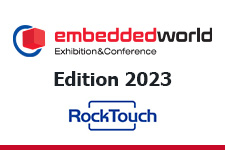
The primary interface has now become a touch panel integrated with a display. Intuitively, everyone, accustomed to smartphones, knows how to operate such a combination.
The quality of the display image and the smoothness of the touch panel operation are crucial in shaping the user experience with an electronic device. The two most important senses - sight and touch - are involved in operating a display with a touch panel. JM Electronics supports its customers in selecting the best solutions, recommending among others RockTouch touch panels integrated with FutureLabs displays.

At the Embedded World trade fair, a summary of the portfolio of these manufacturers was presented, along with previews of several new devices that will soon be added to their offerings.
A notable feature from RockTouch is that they offer capacitive touch panels ranging in size from as small as 4.4” to as large as 32”. The displays come in two edge finish versions (black and transparent), and are typically made of 3mm thick glass, although vandal-resistant models with twice the thickness are available. RockTouch also specializes in custom panels where different glass thicknesses or polycarbonate finishes can be ordered. Additionally, displays can be produced in any shape, color, or even with a company logo or special painting.
RockTouch touch panels not only feature multi-touch capabilities but also support use with gloves. An interesting part of the exhibit was the display of touch panels integrated with open frame displays.
Davide Terrenghi from RockTouch highlighted that today, devices typically require a USB cable connected to the touch panel and an HDMI cable connected to the display. A novel future solution he presented is the use of a single USB-C connection for transmitting images, touch panel control, and audio, replacing the need for three separate cables.
Another focus was on the available optical bonding solutions, where FutureLabs offers displays integrated with touch panels, customizable with almost any shape of empty spaces, fully protected against condensation and contamination. It is also possible to print content under the glass, enhancing the aesthetic quality of the display. Optical bonding significantly improves content quality, offering higher contrast and readability in bright environments.
Also noteworthy is the touch panel integrated with the display, finished with a uniform black surface. This design-centric solution is particularly eye-catching for users.


